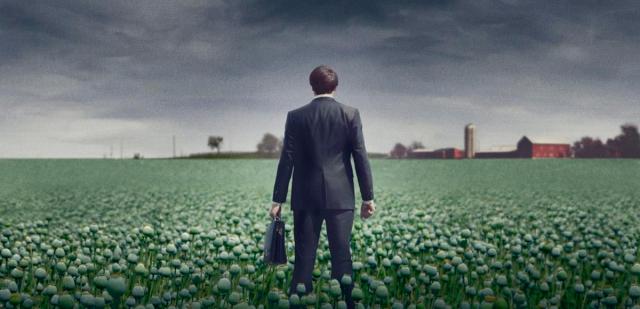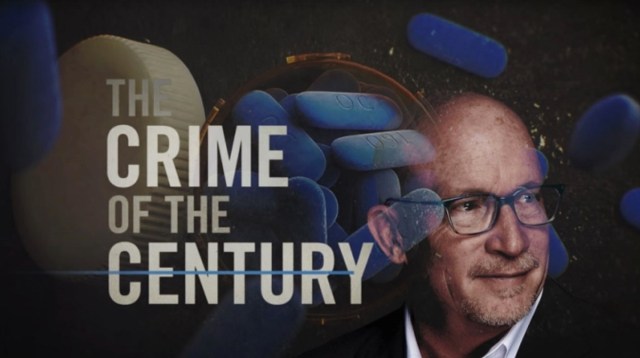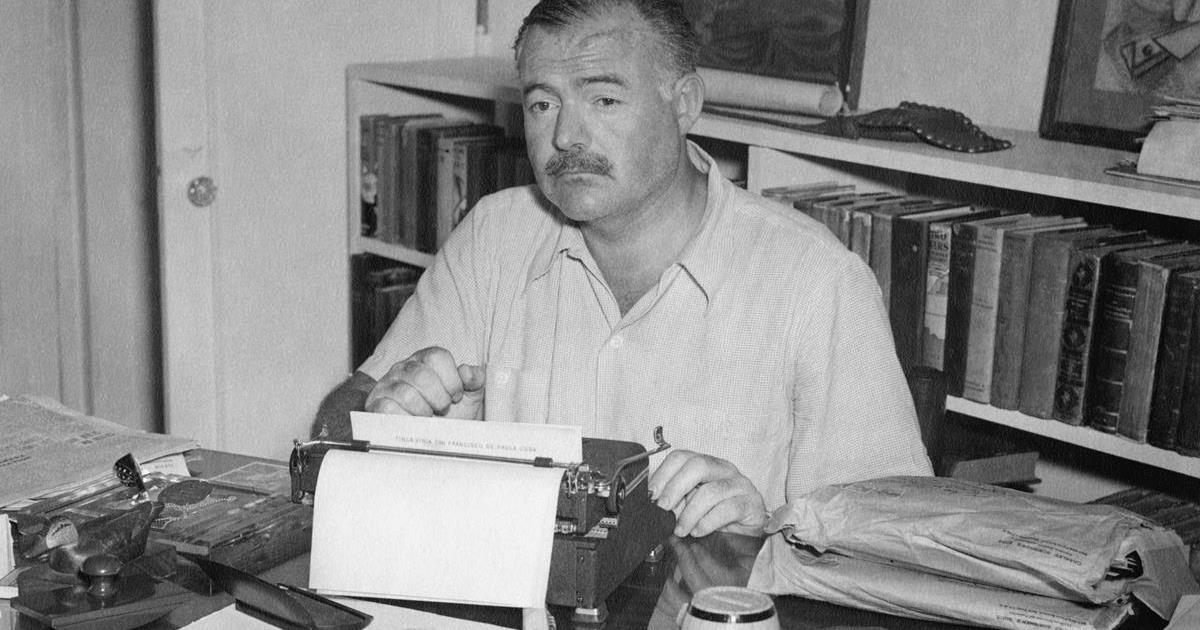
The Crime of the Century, currently streaming on HBO Max, is a new two-part documentary directed by Emmy and Academy Award-winning filmmaker Alex Gibney (HBO’s The Inventor: Out for Blood in Silicon Valley, Going Clear: Scientology & the Prison of Belief).
“The Crime of the Century looks to be another hard-hitting exposé from Gibney, who’s made a career of tackling controversial subjects,” Doug Rapp enthuses at Collider, listing the filmmaker’s numerous awards. “He won three Emmys in 2015 for Going Clear: Scientology and the Prison of Belief, and he won an Oscar for his 2008 look at the U.S. torture and interrogation techniques in Afghanistan, Taxi to the Dark Side. Gibney’s look at another corporate scandal, Enron: The Smartest Guys in the Room, won him an Oscar nomination in 2006.”
READ MORE: First Trailer for ‘The Crime of the Century’ Shows Alex Gibney Tackling Opiod Crisis in HBO Doc (Collider)
A searing indictment of Big Pharma and the political operatives and government regulations that enable over-production, reckless distribution, and mass abuse of synthetic opiates, The Crime of the Century explores the origins, extent, and fallout of one of the most devastating public health tragedies of our time. Reaching half a million overdose deaths this century alone, the documentary reveals that America’s opioid epidemic is not a public health crisis that came out of nowhere.
Written and directed by Gibney, The Crime of the Century was produced by the prolific filmmaker’s Jigsaw Productions in association with The Washington Post andStoried Media Group. With the help of whistleblowers, newly leaked documents, exclusive interviews, sobering testimony from victims of opioid addiction, and access to behind-the-scenes investigations, Gibney’s exposé posits that drug companies are in fact largely responsible for manufacturing the very crisis they profit from, to the tune of billions of dollars and thousands of lives.
Owen Gleiberman, chief film critic at Variety, remarks that pain relief “sounds like an innocuous phrase out of an old Bayer aspirin commercial, but Gibney captures how the elimination of pain has been elevated, by the pharmaceutical-medical establishment, into a false American cult of wellness.”
Pointing squarely at the mostly unseen and highly private owners of Purdue Pharma, Gleiberman adds:
“It’s no accident that the Sackler family, owners of Purdue Pharma, advanced this way of thinking. It was more or less invented in the early ‘60s by Dr. Arthur Sackler, who brought drugs into the age of advertising with the marketing of Valium. OxyContin was sold as a quality-of-life drug, which is how it hooked thousands. And that marked a paradigm shift: From this point on, you could basically walk into a doctor’s office and ask for pain relief. The Crime of the Century is a full-scale vision of how America, addicted to pain relief, embraced the corruption of legalized drug pushing.”
READ MORE: ‘The Crime of the Century’ Review: Alex Gibney’s Shattering HBO Documentary Drills Deep into the Opioid Crisis (Variety)

Part One of The Crime of the Century explores how Purdue Pharma worked closely with the FDA to approve OxyContin for widespread use, touting its safety without evidence and campaigning to redefine pain treatment. In the face of insufficient government intervention, Purdue continued to prioritize profit over the scores of people succumbing to addiction, creating a market for even deadlier opioids.
Part Two “shines a spotlight on the mass marketing of the synthetic opioid fentanyl and examines the connections between drug manufacturers and government policy,” Anthony D’Alessandro writes at Deadline:
“While America’s silent epidemic was killing 40 people a day, Insys Therapeutics, an upstart opioid manufacturer of fentanyl, continued to bribe doctors to overprescribe. A complex scheme to defraud the insurance companies existed side by side with fraudulent marketing tactics while lawmakers continued to turn a blind eye to the implications of a complex pipeline that delivered billions of pills around the country.”
READ MORE: HBO Teams With Alex Gibney For Two-Part Opioid Epidemic Documentary ‘The Crime Of The Century’ (Deadline)

“The Crime Of The Century is a massive undertaking because it’s nearly impossible to summarize the intensity of the opioid crisis in just four hours,” Saloni Gajjar writes at AV Club, underscoring that Gibney’s efforts “work to educate audiences about the people involved in starting and perpetuating this disaster, as well as the amorality and staggering class difference that led to a wholly avoidable epidemic.”
But the wide-ranging condemnation of the opioid crisis is not without its flaws, Gajjar notes. “The documentary presents a data overload, but one that is still a statistical overview as opposed to a more in-depth look at the ramifications of the people who suffered. The Crime Of The Century isn’t abletopaint a complete picture, but it’s still a powerful and edifying watch.”
READ MORE: HBO’s The Crime Of The Century is an incisive but fragmented look at the opioid crisis (AV Club)

In her review for Decider, Meghan O’Keefe similarly grappled with the documentary’s sheer magnitude. “The massive scale of the opioid epidemic’s evil is what makes it so horrifying, but it’s also the one narrative issue I had with the documentary,” she writes:
“Because Gibney is committed to showing the full scope of opioid-related sin, it’s hard to hang our anger on one singular party. Gibney’s most popular past documentaries left us understanding who the villains were and who the victims were. The lines get blurred when it comes to the opioid crisis in part because there are so many at fault and so many who have gotten hurt.”
READ MORE: ‘The Crime of the Century’ Review: Alex Gibney’s HBO Doc Will Leave You Gasping in Horror (Decider)

Daniel Fienberg, chief television critic at The Hollywood Reporter, also found himself searching for a clear villain in his review of the sprawling documentary:
“The closest Gibney comes to a clear onscreen villain is Dr. Lynn Webster of Lifetree Pain Clinic, whose smug answers regarding addiction are intercut with the story of a Utah man whose wife overdosed on drugs Webster prescribed. Like most of the figures here, Webster is decidedly mid-level in a conspiracy that goes all the way to a top only glimpsed in news footage, previously unseen depositions and text-only testimony.”
READ MORE: ‘The Crime of the Century’: TV Review (The Hollywood Reporter)

Yet, in a story of faceless corporate malfeasance powered by greed, David Bauder, writing for The Associated Press, identified three very real villains who appeared onscreen. These are former Purdue sales representative Mark Ross, former federal Drug Enforcement Administration agent Joe Rannazzisi, and Alec Burlakoff, a former sales executive at Insys Therapeutics.
“With the storytelling ability of a born salesman, Burlakoff tells a frightening tale of a corporate culture where doctors were bribed and intimidated to pump out the dangerous drug. Money was the concern, not consequences,” Bauder writes, adding that celebratory videos from Insys events included in the documentary help bring the company’s culture to life.
“He was able to cast all moral qualms to the side and rapaciously and relentlessly sell a drug that he knew was terrible for people, in ways that were utterly reprehensible,” Gibney said to Bauder about Burlakoff. “But he takes us through the process step by step by step in a way that’s just jaw-dropping. You understand ultimately how the crime works.”
READ MORE: Crime of the Century: Alex Gibney on his upcoming documentary and the story of the opioid epidemic (The Associated Press)

Dan Adler, writing for Vanity Fair, details Burlakoff’s participation in the documentary:
“One of the most striking portions of The Crime of the Century deals with Insys Therapeutics, a different company that played a role in the opioid epidemic. Alec Burlakoff, Insys’s former vice president of sales, pleaded guilty in 2018 to a federal count of racketeering conspiracy. He agreed to testify against the company’s founder and former billionaire John Kapoor, who in 2020 was sentenced to 66 months in prison for a scheme to bribe doctors to prescribe the fentanyl-based spray Subsys. In the film, Burlakoff describes the psychology of Insys’s aggressive sales environment in somewhat excruciating detail.”
Burlakoff “was remarkably upfront,” Gibney told Adler. “What he was willing to do was to take me back to the moment in time and give me a sense of the flavor and enthusiasm with which he had committed these crimes.”
READ MORE: The Sacklers Launched OxyContin. Everyone Knows It Now. (Vanity Fair)
While America’s ongoing opioid crisis has been endlessly covered by the media, The Crime Of The Century manages to break new ground with the help of some never-before-seen documentation, interviews and videos, including Department of Justice documents and Richard Sackler’s 2015 deposition for the Kentucky v. Purdue Pharma lawsuit.
In an interview with Katie Kilkenny for The Hollywood Reporter, Gibney discussed how these materials were able to help shed new light on the issue. He called the 120-page prosecution memo “the charging document,” that provided “a level of detail that was really jaw-dropping.” This document “enables us to see exactly how this worked, these plans for flooding the country with OxyContin, how they worked in the field and the result of that is a character like Garry Blinn,” Gibney explained.

The filmmakers wouldn’t have discovered Blinn, a former heroin addict with a higher-than-normal resistance to opiates, who was enlisted by a Purdue Pharma operative for as a kind of a lab rat, if they hadn’t found his name in the memo, Gibney said. One of the first patients to be prescribed OxyContin, Blinn describes how the Purdue representative told him to take as much OxyContin as he needed. “It would take me 15 minutes just to eat ‘em all. Twenty-five, twice a day — it was like sitting down to a bowl of Cheerios,” Blinn says in Part One of the documentary.
“Some of the videos are really illuminating, whether it be the Insys video — which has been broadcast before — or the Purdue video of their ‘97 sales conference, which is really jaw dropping, where they’re singing rock-n-roll songs about selling OxyContin,” Gibney told Kilkenny. “And it’s clear that in that jamboree that they’re conducting, there’s very few skits being done about good patient outcomes; it’s all about making gobs and gobs of money by selling OxyContin, that they were going to surpass Viagra as America’s most profitable drug.”
Richard Sackler’s deposition for the Kentucky v. Purdue Pharma lawsuit was secured with the help of non-profit investigative news organization ProPublica, Gibney said:
“We were able to get access to all of the deposition from Richard Sackler. He’s a character who really hid behind the scenes, he gave very few interviews but you can really get to a sense of how his mind works and how unrepentant he is and how he doesn’t seem to have any regrets. There’s a kind of weird arrogance about it as well as sort of a tone-deafness that is really important to hear. One of the people who asks him, ‘Well, Just because the drug is potent doesn’t necessarily mean it’s effective. I mean, if people die, that doesn’t necessarily mean it’s a good thing right?’ He says, ‘Yes, I suppose death is not a sign of efficacy’ and he sort of chuckles to himself. You think, dude, this is in the middle of an opioid crisis. So it’s a kind of chilling moment that shows you the lack of human concern for the devastation that was wrought by these drugs.
READ MORE: Alex Gibney Talks New Opioid Crisis Doc and Dangers of a “System That’s Enthralled With Money” (The Hollywood Reporter)

None of this would have been possible without the painstaking diligence of newsroom journalists and editors at The Washington Post. The media outlet spent years investigating the opioid crisis, eventually suing the Drug Enforcement Agency for access to a government database that tracked every prescription pain killer from the manufacturer to the distributor to the pharmacy. They were also able to gain access to a trove of documents showing the depth and breadth of the knowledge that pharmaceutical companies had of the epidemic and what they did — or didn’t — choose to do with it.
Scott Higham and Sari Horwitz, investigative reporters at The Washington Post, joined Gibney in a discussion about their efforts in an episode of Washington Live moderated by France Stead Sellers. In the wide-ranging conversation about the events that led to their collaboration with Gibney on Crime of the Century, one stark fact stands out: how much of the evidence had been deliberately hidden from the public’s view.
“There was a plan… for the Department of Justice to charge the three key executives at Purdue with multiple felonies. That would have sent a powerful message to the industry,” Gibney recalled, describing how evidence of this type is typically swept under the rug:
“But as so often happens when you have a powerful corporation, they lean in with powerful advocates, people like Mary Jo White and Rudolph Giuliani, who really brought a lot of pressure to bear on the Department of Justice. The Department of Justice backed down, and they agreed to cut a deal. And the key feature of that deal, while it seemed like a lot of money was being in fines, a key feature of the deal was to bury the evidence that had been collected by prosecutors, which would have given so many people an understanding of how these crimes were working.”
Gibney also described his process for finding characters to help bring life to the tragedy, which he said went back to when he was making Enron: The Smartest Guys in the Room. “The key reporter in that story was a woman named Bethany McLean. And she and I always used to say it’s not about the numbers. It’s about the people. You know, and in this case the same thing is true. In order to be able to tell this story, you have to tell the human story,” he said, recounting their efforts:
“We went out on the road to try to find people who could — who could carry the burden of this story. We found a number of what I will call detectives. In addition to Scott and Sari and Lenny, who were all in the film, you know, there were some people who were on this story early on, a New York Times reporter named Barry Meier, Patrick Radden Keefe from The New Yorker, but also, you know, there was a character that actually The Washington Post discovered, a kind of Walter White-like character named Caleb Lanier, a guy who had a terrible back issue, you know, was in an awful accident, stated taking OxyContin. At some point, you know, his tolerance went up. He couldn’t afford it anymore. He turned to heroin. Then he realized, oh, my gosh, you know, what about fentanyl? It’s so much cheaper? And not only that, I can import it from China, and then I can deal it and cover my costs now that I’m addicted to opioids but also make money. And so, you could see the whole cycle in one character.”
READ MORE: “The Crime of the Century”: A Conversation with Alex Gibney, Scott Higham & Sari Horwitz (Washington Post Live)

In a separate interview with Kilkenny, Gibney describes why he became interested in the opioid crisis in the first place. “There was a sense that this was not something that just happened, that there was a series of interlocking crimes here,” he said, “And that was interesting to me, because it seemed that what was missing about understanding and fixing the opioid crisis was redefining it, so it wasn’t just a natural event like a hurricane or a flood, but that it was a crime. And if there are crimes, then there are people to be held to account, and there’s a way of fixing things so the crimes don’t happen again.”
With 500,000 dead, “it just seemed that big,” Gibney said, adding that by “century” he very much meant the 21st Century, so he didn’t have to contend, or compete with, with previous crimes from the previous 100 years.
“This is very much a crime of this century,” he added. “In other words, Purdue launches Oxycontin in the late ’90s, but most of the damage done from opioids is in the 2000s, so it seemed appropriate — both the enormity of it and the timing.”
READ MORE: Alex Gibney on Why He Takes on the Opioid Crisis in ‘The Crime of the Century’ Documentary (The Hollywood Reporter)





